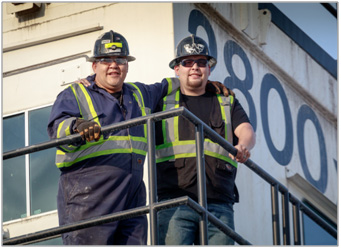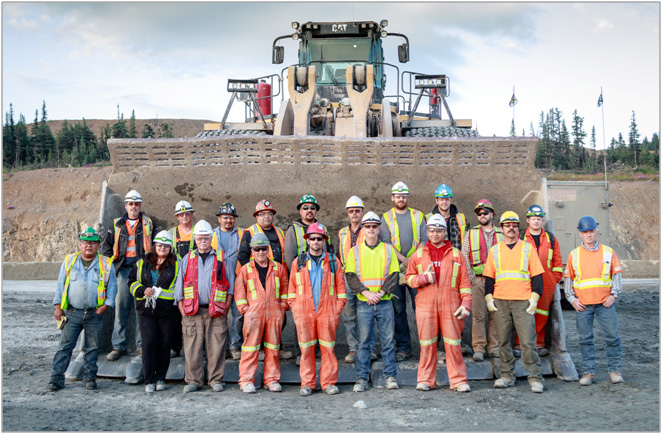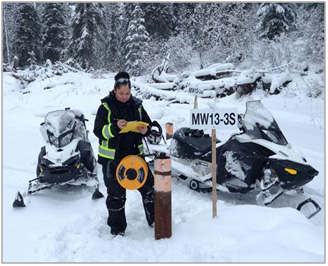- Home
- Corporate
- Operations
- Exploration
- Shareholders
- Careers
- Site Map
- Contact
- Legal Notice
- Privacy Statement
Copyright © 2025
Imperial Metals
All rights reserved.
Imperial Metals
All rights reserved.
The Company and its subsidiaries are committed to responsible, sustainable resource development. Mine operations are proactive and progressive in providing safety training and education and a safe working environment for all employees, and are consistent and steadfast in supporting environmental research.
Red Chris, Mount Polley and Huckleberry mines are important drivers of economic growth and social prosperity in their regions. They provide assistance and participate in activities that benefit local communities and the environment. They engage in open and direct dialogue with all regulatory agencies, local communities and First Nations. The Red Chris, Mount Polley and Huckleberry mines continue to build and foster strong, mutually-beneficial relationships with First Nations based on active training, First Nation employment, consultation, communication and cooperation.
The process of turning rock into value is entirely dependent on people and the expertise they lend to this task. Which is why our most valuable resource is our workforce of over 924 employees and contractors. They are fundamental to the success of the Company and the regions in which we operate. We are committed to working with leadership and members of the community to assist them in meeting their objectives with a focus on youth, education and health.
We work closely with and support regional educational institutions whose programs are geared to the next generation of geoscientists, engineers, trades and other skilled positions. Employment opportunities have been and continue to be provided to students in recognized mining related Co-Op programs. We utilize students when possible to assist with seasonal work demands. These initiatives provide valuable work experience that support student’s educational objectives and provides financial assistance while completing their studies. We also provide apprenticeship opportunities.
The value of these programs extends beyond acquiring skills and qualifications - they help to create a foundation for sustainable communities.

Collectively Imperial, its subsidiaries and their employees support a range of charitable organizations across the province including BC Children’s Hospital, the United Way, Big Brothers and Big Sisters. We also provide support and are active with the Association for Mineral Exploration of BC, the Mining Association of BC, the Mining Association of Canada, BC Chamber of Commerce, the BC Business Council, and government associations such as the Union of BC Municipalities, the North Central Local Government Association and First Nation Communities.
Red Chris Development Company Ltd. (RCDC) and the Tahltan Nation signed an Impact, Benefit and Co-Management Agreement (IBCA) in July 2015. The IBCA, which was approved by a community referendum, provides the basis for a life-of-mine partnership covering revenue sharing, education, training, employment and contracting opportunities, capacity support and provisions for communication and interaction on social and environmental matters. A Project Advisory Committee (PAC) was formed with the responsibility to oversee the implementation of the IBCA, and to strengthen relations with the Tahltan Nation through cooperative management procedures, employment, contracting, sponsorship and community support activities. As part of the initiatives under the IBCA an HR Inventory database with an Essential Skills component is being developed for the Tahltan membership that will help identify candidates for work at the mine based on the projected workforce requirements and facilitate the development of the training plan.

Community support activities and engagement continue, and include support for literacy, cultural & fish camps, support with the Job Fair in Dease Lake, Tahltan Day events, weekly ice hockey games, the annual Dease Lake hockey tournament and fundraising initiatives like the Tour de Telegraph bike ride and TNDC family Christmas party. First Nation employees represent approximately 35% of the permanent workforce at the Red Chris mine.
Mount Polley Mining Corporation (MPMC) entered into a Participation Agreement with the Williams Lake Indian Band (T’exelc First Nation) in December 2011 and the Soda Creek Indian Band (Xatśūll First Nation) in May 2012. These agreements were the first in the Province between First Nations and a pre-existing operating mine in British Columbia, and resulted in a high level of engagement and communication with the leadership and members of the Xatśūll and T’exelc First Nation communities. More recently, this strengthened relationship provided a critical foundation for communications and cooperation following the Mount Polley tailings dam breach. Meetings are regularly held with these First Nations to ensure consultation on all ongoing development and future plans for the mine. A Revised Participation Agreement with the Williams Lake Indian Band was signed in August 2016 further strengthening the relationship between both parties. MPMC is in discussion with the Soda Creek Indian Band regarding revision of that agreement as well.
Mine management work closely and cooperatively with First Nation representatives, government regulators, and other stakeholders to assure environmental management is consistent with relevant regulatory requirements and the needs of stakeholders and the local First Nations, and meets the highest industry standards. One of the key commitments is to maintain water quality that will sustain aquatic life. Aquatic life is the most sensitive user of water; therefore, by protecting aquatic ecosystems, other water users (recreational, drinking water, wildlife) are also protected. Water quality is closely monitored to ensure the requisite water quality criteria to protect aquatic life are achieved.

Red Chris is pioneering environmental management by producing a comprehensive Environmental Management System (EMS). The EMS consists of a series of management procedures and monitoring programs that integrate engineering design and environmental planning to maximize the mitigation of potential impacts of the mine on the environment. The EMS contains three key elements: a series of integrated environmental management plans, a formal environmental awareness and training program, and ongoing environmental monitoring plans. The EMS also contains a comprehensive Wildlife Management Plan specifically focused on the potential impacts of the mine on the local wildlife. In particular, mountain goats and stone sheep, which inhabit the surrounding areas of the Red Chris site, are monitored to identify whether mine activities influence their use of habitat.
The Wildlife Management Plan makes extensive use of remote cameras, which provide both real-time still and video recordings of animal movements. The Environmental Impact Assessment (EIA) predicts concentrations and loadings to the receiving environment, and provides recommendations for a series of surface water, effluent and aquatic monitoring programs throughout the life of mine. Monitoring programs designed, developed and implemented by EIA biologists are designed to calibrate and check the conceptual and predicted findings.
The Red Chris Monitoring Committee (RCMC) is a requirement of the Mines Act Permit. The RCMC is co-chaired by representatives from Red Chris and the Tahltan Nation. The RCMC meets regularly, and includes representatives from the Tahltan, Red Chris, the Ministry of Environment, the Ministry of Energy, Mines and Petroleum Resources and the Ministry of Forest, Lands and Natural Resource Operations.
An Environmental Oversight Committee (EOC) has been established under the IBCA and is a forum for dialogue between RCDC, Tahltan Central Government and Tahltan Nation representatives. The EOC terms of reference lays out environmental management mechanisms for the committee relating to the EMS, the project’s environmental compliance, monitoring and performance, all project related environmental information and makes recommendations to the PAC concerning environmental matters, federal and provincial permit applications and environmental monitoring programs.
Mount Polley has developed and updates a comprehensive environmental monitoring plan (CEMP) on an annual basis. The CEMP evaluates the effects of mining related activities on surface and groundwater quality, sediments, soils, periphyton, phytoplankton, benthic invertebrates, zooplankton, fish, vegetation and wildlife. Additionally, supplemental monitoring plans are implemented beyond permit requirements to ensure protection of the environment. The Mount Polley mine has a positive water balance that is managed by minimizing site contact water, recycling of on-site water and enhanced evaporation techniques. Excess contact water is directed to a water treatment plant and discharged through diffusers at depth into Quesnel Lake, as authorized by an Environment Management Act permit issued by the BC Ministry of Environment.

The Mount Polley Public Liaison Committee (PLC) includes representatives of the mine, local First Nations, local communities including Likely, Big Lake and Horsefly, the Cariboo Regional District, and a number of provincial and federal government agencies. The PLC meets at least quarterly to provide an opportunity for the mine to share information about mine activities and results of monitoring programs with the members, and for the members to ask questions and share information and any concerns of their constituencies with the mine. In addition to the PLC, the mine has an Implementation Committee that meets regularly with the Williams Lake Indian Band and the Soda Creek Indian Band as a component of the Partnership Agreements. The mine also hosts site tours and public meetings for local community members and distributes a community newsletter.
MPMC continues implementation of Towards Sustainable Mining (TSM), a program administered by the Mining Association of Canada that provides a public and transparent commitment to responsible mining.
As a new operation, 2018 will be the first year for Red Chris to submit a TSM report. The principles of TSM demonstrate leadership in the areas of aboriginal and community engagement, tailings management, globally recognized environmental practices, and a commitment to the safety and health of employees and surrounding communities. TSM’s tools and indicators drive performance and ensure key mining risks are managed responsibly.

The commitment to sound occupational health and safety practices is a priority for the Red Chris, Mount Polley and Huckleberry mines. Continuous safety training and education is the foundation of maintaining a positive safety culture. Emphasis on continuing program improvements, as well as establishing new safe operating procedures where required, is managed through the Joint Occupational Health and Safety Committees (“JOHSC”). Operating procedures are regularly reviewed and revised to ensure health and safety standards are met. Pre-task hazard assessments and job hazard analyses continue to be a priority. They are essential and mandatory tools that aid in the identification of hazards and the mitigation of associated risks in order to maintain a healthy and safe work environment.
Red Chris JOHSC members participated in a Musculoskeletal Disorder (“MSD”) training course designed by the Ministry of Energy, Mines and Petroleum Resources, which focused on identification and assessment, and mitigation procedures in the work place. Initiatives to reduce MSD at the Mine site have been implemented.
An extensive Site Monitoring Program was conducted at Red Chris, with the guidance of Golder Associates Certified Industrial Hygienists. An Industrial Hygiene review and Risk Assessment was completed.
Red Chris was successful at the 2017 Provincial Mine Rescue and First Aid competition achieving awards at the Zone and Provincial levels.
Mount Polley has made improvements to various site control systems related to the mill and truck shop fire suppression, crusher building dust collection, fume and chemical exposure systems in the assay lab, mill and welding shop. MPMC maintains an active Mine Rescue team and continues to review and develop various components of its mine safety program, as well as implementation and improvement of the risk management programs. An updated Field Level Hazard Assessment has been implemented to provide a set of comprehensive tools for employees and contractors to use as part of their pre-job hazard assessment.
All three mines have a fully functioning Independent Engineering Review Panel and Dam Safety Managers. The Tailings Operations, Maintenance and Surveillance manuals and the Emergency Preparedness and Response plans were updated in 2018.